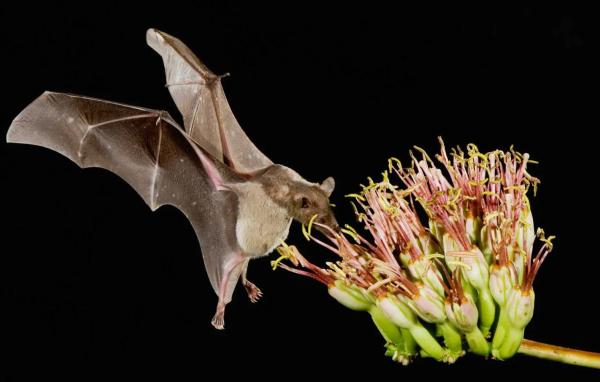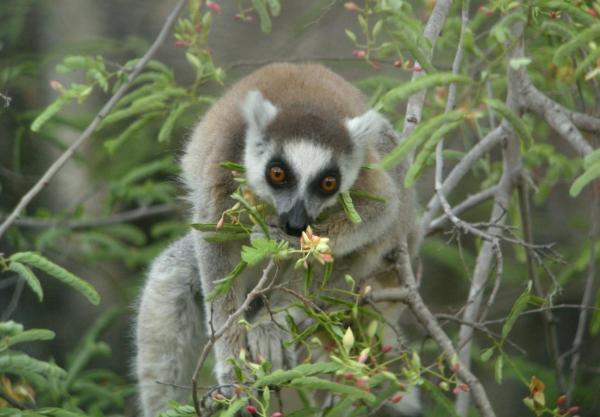What Animals Pollinate? - Pollinators Examples


Pollinators are animals that pollinate plants thanks to their natural behavior. Often this is in the form of feeding on plants and carrying pollen from one flower to the next one. Other animals can pollinate simply by walking past plants and carrying pollen on their coats. The fertilization of flowers occurs through the transmission of pollen from the anthers to the female stigma of the plant. From this fertilization the fruit and seeds will be produced. Pollinating animals use their senses to locate plants, the latter often emitting scents or using colors to attract pollinators.
We can learn more at thedailyECO as we ask what animals pollinate? We answer this question by providing a list of pollinators examples with photos to see what they look like.
- Western honey bee (Apis mellifera)
- Longwings (Heliconius spp.)
- Violetears (Colibri spp.)
- Elephant hawk moth (Deilephila elpenor)
- Hummingbird hawk-moth (Macroglossum stellatarum)
- Greater long-nosed bat (Leptonycteris nivalis)
- Buff-tailed bumblebee (Bombus terrestris)
- Ring-tailed lemur (Lemur catta)
- Mauritius ornate day gecko (Phelsuma ornata)
- Fig wasps (family Agaonidae)
- Other pollinating animals
Western honey bee (Apis mellifera)
Honey bees are perhaps the most well-known animals which pollinate. They they feed mainly on pollen and nectar of plants and then pass this on to the flowers of other plants. They are exclusively diurnal pollinators and use sight to find flowers.
Honey bees sit on the flowers where the pollen is transferred. This occurs thanks to hairs on their body to which the pollen adheres. You can see this if you look closely at the photo below. They also have a structure on their feet called a scopa where they collect pollen. They are very specific pollinators, and collect pollen from a single plant species on each day.
Learn more about these fascinating type of pollinator with our article on how do bees communicate?

Longwings (Heliconius spp.)
Butterflies commonly approach flowers to extract nectar with the help of a long tongue called a proboscis. For this they perch on the flowers and rub their body against the pollen they help to distribute. Butterflies from the widepsread genus Heliconius particularly feed on pollen, making them some of the best butterflies that pollinate. They are commonly known as bursh-footed butterflies with the pollen sticking to their fuzzy legs. They rely heavily on colors to identify flowers.
All butterflies begin as caterpillars. Discover some of the most deadly poisonous caterpillars in the world.

Violetears (Colibri spp.)
Violetears are hummingbirds from the genus Colibri. They are such important pollinators that they are sometimes known as feathered bees. Hummingbirds are nectarivores with a very high energy demand due to the rapid flapping required by their suspended flight, an example of which you can see in the photo.
Hummingbirds originate in the Americans where it is estimated that 8,000 plants depend on them for pollination. They have a long beak with which they forage into mainly plants with bell-shaped flowers and this beak becomes impregnated with pollen as it passes from flower to flower. This is how these animals pollinate.

Elephant hawk moth (Deilephila elpenor)
As we continue to look at what animals pollinate, moths are often overlooked as pollinators because they are nocturnal, but they also contribute to this important process. This species in particular will come close to feeding on flowers that produce nectar at night. This is thanks to their night vision with which they distinguish between color differences. They mainly choose light-colored flowers that create contrast with the night. This species is such an important pollinator that it is responsible for 5-10% of local plants.

Hummingbird hawk-moth (Macroglossum stellatarum)
As you can see in the photo below, this insect is a moth that closely resembles a hummingbird, hence the name of this pollinator. This similarity is also reflected in the occupation of the niche, since the hummingbird hawk-moth feeds on floral nectar by hovering over the flowers, just like these birds. They use their excellent eyesight to locate the suitable flowers. Due to the contact it has with the flowers, it helps to pollinate them and carry said pollen from one place to another.

Greater long-nosed bat (Leptonycteris nivalis)
When we think of animals that pollinate, we may think of insects first. However, there are mammals that pollinate. One of the most important are nectar-eating bats. Together with the lesser long-nosed bat (L. yerbabuenae) the greater long-nosed bat us responsible for pollinating the maguey. This is the plant from which tequila, mezcal and pulque are obtained. Once the flower emerges the plant will die, so it must be cut before flowering for the tequila industry. To ensure the survival of the plant, some flowering plants are usually left.
Learn more about one type of bat with our article on hematophagy in animals.

Buff-tailed bumblebee (Bombus terrestris)
Bumblebee workers have basket-like appendages on their hind legs, called corbicles. It is here in which they store the pollen they collect from flowers. To get the pollen on the legs, they lick their entire body to collect all that has adhered to them and then gather it in the corbicle. This pollen will serve as food in the hive. As they go from flower to flower, they end up depositing a part of the pollen that they carry from one to another, facilitating pollination.

Ring-tailed lemur (Lemur catta)
Lemurs are mainly herbivorous omnivores, feeding especially on plant matter such as fruits, flowers and even exudates such as resins or nectar. You can see them feeding in the photo below. For this reason, it is common to find them licking flowers or cutting them to eat. During this process, the pollen adheres to the nose and hands, being transported from one place to another. They are not strict herbivores as they are also known to eat insects and even small vertebrates.
Learn more about lemurs and related animals with our article on what are primates?

Mauritius ornate day gecko (Phelsuma ornata)
When thinking of what animals pollinate, it is not common to think of reptiles. However, the Mauritius ornate day gecko is one such non-insect pollinator which feeds on the nectar of plants. As their name suggests, these plant are those endemic to Round Island in Mauritius. It is common to see their face full of pollen. This is what they take from one plant to another. Pollinating reptiles are not very frequent. The few that exist are underestimated in terms of their pollinating capacity.

Fig wasps (family Agaonidae)
Figs are fruits that require this family of wasps to pollinate. Similarly, these wasps need the figs to develop their life cycle. This is an important example of symbiosis in nature. The fig wasp will enter inside the fig, which is an inverted flower. They do so to reproduce and lay eggs inside. During this process they will pollinate the flowers so that the fruit matures.

Other pollinating animals
Now we know what animals pollinate, we can take a look at some more examples of pollinators in nature:
- Horse-flies (family Tabanidae)
- Wasps (Vespula spp.)
- Darwin wasps (family Ichneumonidae)
- Housefly (Musca domestica)
- Common lagoon flies (Eristalinus aeneus)
- Green lacewings (family Chrysopidae)
- Melipona bee (Melipona beecheii)
- Common carder bumblebee (Bombus pascuorum)
- Long-billed hermit bird (Phaethornis longirostris)
- Ants (Plagiolepis pygmaea)
Now you know about different pollinating animals, you might want to know more about the process of how plants reproduce. You can do just that with our article on the difference between angiosperm and gymnosperm plants.
If you want to read similar articles to What Animals Pollinate? - Pollinators Examples, we recommend you visit our Biology category.
- Reddi, C. S., & Bai, G. M. (1984). Butterflies and pollination biology. Proceedings: Animal Sciences, 93, 391-396.
- Beatty, R., Beer, A., & Deeming, C. (2010). The book of nature. Great Britain: Dorling Kindersley.
- Moldowan, P. (2019) Lizard pollution: the stigma of having food on your face. Front Ecol Environ, 17(10), 574–574.














